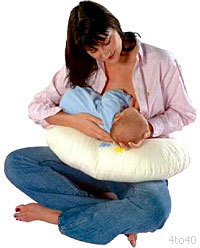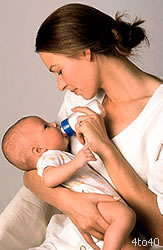 While there is no doubt that breast milk is best for the baby, it will always be true that for one reason or another, a small minority of mothers will not be able to adequately breast feed their babies and will have to resort to feeding by bottle or a cup.
While there is no doubt that breast milk is best for the baby, it will always be true that for one reason or another, a small minority of mothers will not be able to adequately breast feed their babies and will have to resort to feeding by bottle or a cup.
Usually a four to five month old baby can successfully be fed by a cup, but it may be difficult to do so in a younger baby. Wherever possible, a cup should be used in preference to a bottle, because it is so much easier to clean.
There are some traditional spoons with a long spout, such as a paladai or jhinook, and it is much easier to feed with these than an ordinary spoon. I have even seen one or two month old babies being fed successfully with these spoons by the mother. But if you have to use a bottle, then you should be very meticulous about bottle hygiene.
Cow’s or Buffalo’s Milk
Cow’s or buffalo’s milk are often used instead of mother’s milk. For the first six to eight weeks, the milk may be diluted with one part of water to three parts of milk and sugar. One level teaspoon of sugar may be added for every 75 to 100 ml of milk. After the baby is more than eight weeks old, dilution is not necessary and the baby should be given undiluted milk with added sugar.
Buffalo’s milk is very rich in fat. This can be reduced by removing the top layer of cream (malai) after boiling.
Powdered Milk
 While using powdered milk it is important to remember that the scoop should be filled level and not heaped. Usually, 30 ml of water is needed for one scoop of milk powder. It is important that the water for making up the milk should be boiled. The spoon and the katori or bowl needed to mix the milk should also be boiled along with the bottles. Many brands can be mixed directly in the bottle. You should wash your hands properly before making the feed.
While using powdered milk it is important to remember that the scoop should be filled level and not heaped. Usually, 30 ml of water is needed for one scoop of milk powder. It is important that the water for making up the milk should be boiled. The spoon and the katori or bowl needed to mix the milk should also be boiled along with the bottles. Many brands can be mixed directly in the bottle. You should wash your hands properly before making the feed.
You may want to go out and leave the baby with someone else at home. What about his feed? A feed can be made up and left in the refrigerator or the icebox. It will need to be warmed by placing the bottle in a bowl of hot water for a few minutes. Before giving it to the baby, pour a few drops of milk on your arm to make sure that it is not too hot. Many babies happily take cold milk. If there is no facility to keep the milk refrigerated, or if you are travelling, the milk can be kept in the bottle for one or two hours in summer and a little longer in winter. You should remember that germs grow very rapidly in milk, particularly in warm weather. If you do not have an icebox or a refrigerator, fresh milk becomes a problem and powdered milk should be used instead.
 Kids Portal For Parents India Kids Network
Kids Portal For Parents India Kids Network






